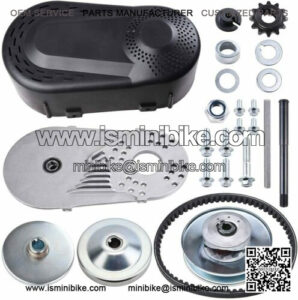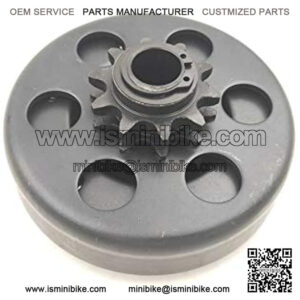What Does a Go-Kart Torque Converter Do?
Torque Converter features
- Engages at about 1,500 RPM
- Consists of 2 pulleys
- Variable transmission
- Disengaged while idling
Torque converters are one of the two popular transmissions found on go-karts. A torque converter is a mechanical device that is attached to the side of the engine. As you can see in the image above, it runs on a two-pulley system. The smaller pulley, called the driver pulley, is attached to the engine’s crankshaft. The larger pulley is referred to as the driven pulley.
The driver pulley is connected to the driven pulley via a drive belt. On traditional setups, the crankshaft is directly connected to the rear axle via a sprocket and a chain. However, on a torque converter setup, there is a jackshaft that connects the driven pulley to the rear axle via sprockets and chains.
When idling, torque converters are fully disengaged. This means that even though the engine has started, the go-kart doesn’t move. Once the engine reaches an RPM of about 1,500+ the driver pulley starts to clamp on the belt, which in turn engages the driven pulley. The rotational force is subsequently applied to the jackshaft and rear axle, giving your go-kart motion.
What is interesting here is that as the driver pulley starts clamping on the belt, it decreases the gear ratio. Typically, the gear ratio will start above 2:1 and the higher the RPM the lower it will decrease the ratio to below 1:1. With regards to costs, torque converters are relatively affordable. However they’re a little more expensive than clutches, as they contain more parts.
What Does a Go-Kart Clutch Do?
Clutch features
- Fully engaged at around 1,800 RPM
- Friction material pushes outward
- Suitable for high speeds
- Uses a sprocket and roller chain
On the other hand, a go-kart clutch is a non-variable transmission. This means that it has a fixed gear ratio, which is set by the crankshaft sprocket and rear axle sprocket sizes. The gear ratio remains the same across all RPM ranges of the engine.
There are many types of clutches that are used on go-karts, however the most common are dry centrifugal clutches. A centrifugal clutch consists of 4 essential components. An outer drum, which can be seen in the image above, encases the interior components. The drive sprocket is attached to the drum, and connects to the rear axle via a roller chain.
In the interior, you’ll find the friction material, which is held together by an arrestor spring. The internal components do not make contact with the drum, as the arrestor springs hold them together. The entire clutch is mounted on the crankshaft and turns, as the crankshaft spins.
At about 1,400 to 1,600 RPM enough force is exerted onto the spring that the friction material slowly starts to move outward, due to the centrifugal force. As the force is still not enough to make contact with the drum, the clutch is still “slipping”. This is not ideal, as it creates heat and wear on the components, while the kart isn’t really moving. Only at about 1,800 RPM enough force is applied and the friction material presses against the drum and the clutch is fully engaged, spinning the driver sprocket and the rear axle.
Differences: Go-Kart Torque Converter vs Clutch
The way a torque converter operates compared to a clutch is very different. The main difference is that torque converters idle before they engage and they start to engage at around 1,700 RPM. Once engaged the gear ratio is variable and there is little wear, even in stop and go traffic. The same can’t be said for clutches.
While clutches engage earlier, they have a slip range at about 1,400 to 1,600 RPM. Slipping can cause increased heat and wear on the parts. However, once a clutch is fully engaged, it feels much snappier.
This makes clutches more ideal for situations where you’re constantly engaging in higher speeds on the upper torque range. Torque converters on the other hand handle low torque ranges better, due to the variable gear ratio and the ability to easily disengage at lower RPMs.
About clutch
“go kart clutch assembly”
“go kart clutch harbor freight”
“go kart clutch vs torque converter”
“go kart clutch problems”
“go kart clutch removal”
“go kart clutch smoking”
“go kart clutch 1 inch bore”


